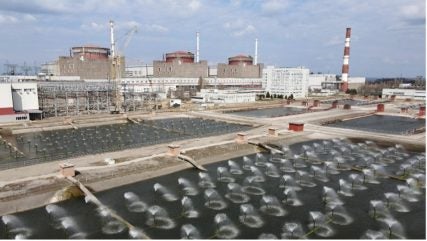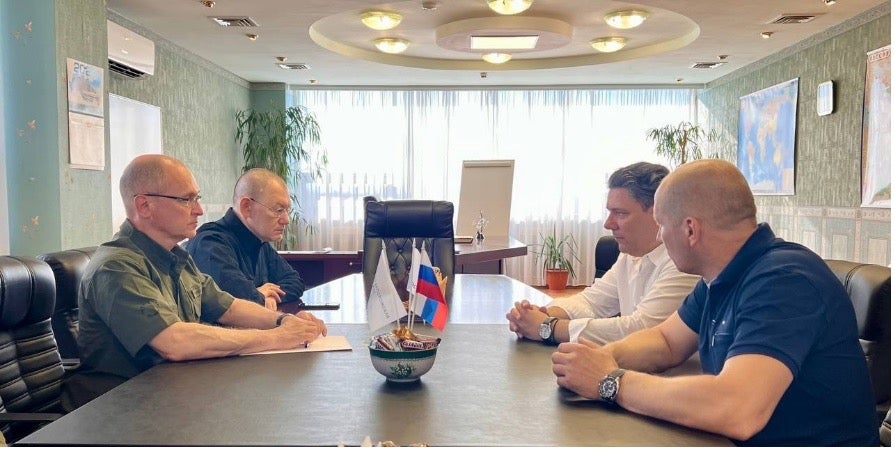
The water level in the cooling pond at the Zaporizhia NPP (ZNPP) continues to decrease, International Atomic Energy Agency (IAEA) Director General Rafael Mariano Grossi said in his latest update. Despite all reactors remaining in a state of cold-shutdown, availability of this water is important for nuclear safety of the plant.
Over the past weeks, IAEA experts at the plant have observed a continuous decrease in the water level of the plant’s cooling pond. If this trend continues, ZNPP staff confirmed that it will soon become challenging to pump water from the pond. Maintaining the level of the pond is made more difficult by the hot summer weather.
Following the destruction of the Kakhovka dam last year, ZNPP dug 11 groundwater wells to provide approximately 250 cubic metres of cooling water per hour to the sprinkler ponds. These ponds supply sufficient water to cool all six reactor units in their current cold shutdown state. During a site walkdown, the IAEA team observed that the sprinkler ponds are functioning well, with water at nominal levels. Any compromise to the availability of water to the sprinkler ponds might necessitate using the cooling pond as a back-up source.
“The dwindling water levels in the cooling pond remains a potential source of concern, and we will continue to closely monitor and observe the situation at the site to ensure the availability of a sufficient supply of cooling water for the plant’s needs at all times,” Grossi said.
The IAEA experts also continue to monitor vital maintenance activities across the site over the past week. They were informed that the majority of the maintenance work at the plant is being performed by contractors. The team observed tests of the emergency diesel generator for a safety train of unit 6, from both the emergency diesel generator room and the emergency control room. Similarly, they observed the emergency diesel generator testing for a safety train of unit 5 from the both the emergency diesel generator room and the main control room. No issues related to nuclear safety and security were noted during these tests.
Additional walkdowns were carried out across the ZNPP site to monitor nuclear safety and security. The team also noted that the three main fuel tanks at the diesel fuel farm can only be filled to a maximum of 90% of their capacity and that maintenance is planned on the tanks.
The team visited the 750 kilovolt (kV) switchyard and did not observe any new issues with respect to safety and security. Also, last week the team conducted a series of walkdowns and discussions on the topic of the safety and security of radioactive sources.
During a walkdown of the reactor hall and safety system rooms of unit 5, the team observed the switching of the spent fuel pool pump and confirmed that both the pumps and safety system rooms were in good condition.
The IAEA team said it continues to hear military activity at varying distances from the plant. The team also observed smoke in the distance multiple times in the past week, which the ZNPP reported was caused by fires.
Meanwhile, ZNPP reported on its Telegram channel that First Deputy Head of the Presidential Administration of Russia, Sergey Kiriyenko, visited the plant during his working visit to Energodar. Kiriyenko headed Rosatom during its formative years from 2005 until 2016 and has maintained his interest in the nuclear industry.

He held a discussions on the current situation with ZNPP Director Yuriy Chernichuk who reported on the measures being taken to ensure the safe operation of the plant. Chernichuk also spoke the development plans for the plant. The meeting discussed preparations for the new autumn-winter period and measures taken by power engineers together with the municipality aimed at improving the sustainability of the energy and heat supply system ZNPP’s satellite city of Energodar.
The Mayor of Energodar, Eduard Senovoz, said in his Telegram channel that during Kiriyenko’s visit to the city, they discussed the current situation, development projects, as well as the progress of repairs to social facilities of the city, which are being carried out with the help of Rosatom. They jointly visited School No 2 and checked the progress of major restoration works.
The head of the Zaporozhye region Yevgeny Balitsky, reported in his Telegram channel that, at his meeting with Kiriyenko, they discussed the status of educational organisations for the new academic year. They talked about the readiness of universities and general education schools including staffing and methodological support. Balitsky stressed that Kiriyenko set the task of developing comprehensive security during the preparation and conduct of the educational process and the organisation of transport traffic near educational institutions.
Kiriyenko also visited the Orthodox church of Energodar, the Epiphany Cathedral, where restoration work is nearing completion. Construction began more than a quarter of a century ago, but then it was stopped during Ukraine’s control, and for more than 10 years, services were held in the basement. Construction was resumed only last year with the help of Rosatom.






